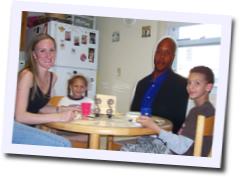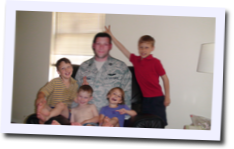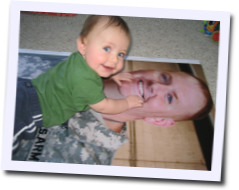


On September 30, 2006, I read an article in The New York Times that I don’t think I’ll forget. “When Soldiers Go to War, Flat Daddies Hold Their Place at Home” was the headline of Katie Zezima’s report on the Maine National Guard’s “Flat Daddy” or “Flat Soldier” initiative, in which life-size waist-up photographs of deployed soldiers were given to their families waiting at home. (1)
According to Zezima, the Flat Daddies became part of daily rituals—some came to soccer practice and sat at the dinner table—some were there for special occasions such as weddings, a 50th birthday party and even a pre-kindergarten graduation. One Flat Daddy almost made it to a Denver Broncos game, but in the end he had to wait in the car because it was raining.
Sergeant First Class Barbara Claudel, director of the Maine National Guard’s family division remarked on the popularity of Flat Daddies: “‘The response has been unbelievable….The families just miss people so much when they’re gone that they try to bring their soldier everywhere.’”
When I read that quote I thought maybe I had accidentally grabbed The Onion instead of the The New York Times—in the face of unnecessary deployment, the National Guard’s perfunctory gesture struck me as downright tacky. But Flat Daddies were indeed going like hotcakes—over 200 had been requested and distributed in the first nine months of the program and were clearly very meaningful to their recipients. The article opened with an anecdote describing a family photo shoot on 9-year-old Baylee Smith’s first day of school. Since Baylee’s father, Mark Smith, was stationed in Afghanistan, his likeness stood—or, more accurately, was propped—in for him:
“‘Where’s Flat Daddy?’ an excited Baylee asked as her stepmother Jennifer Smith pulled a large cardboard picture of Sergeant Smith, in his uniform, out of her Chevy Blazer and propped him up on the bumper. The two, along with Ms. Smith’s young sons, Alec and Derek, posed for a picture with their Flat Daddy, who promptly fell down. ‘Stop it Dad, that’s not funny. It’s not a joke,’ Baylee said with a laugh…”
So really, who was I to judge Flat Daddies? The fact is, this sort of intimate, tactile use of and physical engagement with photographs is widespread and ubiquitous.
I would put Flat Daddies in the category of visual production that the photography historian Geoffrey Batchen has termed “vernacular photographies.” (2) Conceived and produced to be used in everyday life, vernacular photographies are objects and rituals whose value is determined not by aesthetic or monetary standards, but by their emotional meaning and functional purpose for their owners: lockets, albums, photo-printed textiles and clothing, etc.
Vernacular photographies populate cultural artifacts that range from Roland Barthes’ last text Camera Lucida in which the author desperately searches for the essence of his mother in the Winter Garden Photograph, to another 1980s classic, Major League, where, for each of their successes, the downtrodden Cleveland Indians get to strip one article of clothing off a life-size photograph of their showgirl-cum-team manager.
In real life, two summers ago I did research in Kumasi, Ghana on the ways in which photography is incorporated into contemporary funeral practices, one of which is the funeral’s culminating event where everyone dances and waves handkerchiefs (sometimes with silkscreend photographs) around a central photographic display of the deceased. I was reminded of this tradition the other day when The New York Times featured a photograph of friends and family caressing a poster-sized image of Sgt. Alex R. Jimenez of Corona, Queens who died in Iraq in May; what I had seen in Ghana and what I saw in Queens both seemed to relate to the photograph of a woman kissing a photograph of Karadzic in an article about developments at The Hague.
All these poignant interactions with photographs (okay “poignant” is perhaps a stretch when applied to Charlie Sheen) were summoned for me last Thursday when The New York Times ran its “Roster of the Dead”: i.d. photographs of 563 American service members who have died since the beginning of the war in Afghanistan on October 7, 2001 in the name of Operation Enduring Freedom.
In that tidy grid, the sheer quantity of tiny faces (with mostly happy expressions) made it so hard to believe that none of them was living anymore. I suppose I was overwhelmed by a seeming contradiction: visually, the concentration of vitality that spread across two full-pages was produced by an accumulation of images—but the very adhesive of this accumulation, was cumulative death.
I dug up my Flat Daddies clipping to see if any of the real daddies mentioned there were back in the paper two years later. It was a small comfort that they weren’t.
(1) Katie Zezima, “When Soldiers Go to War, Flat Daddies Hold Their Place at Home,” New York Times (September 30, 2006), https://www.nytimes.com/2006/09/30/us/30daddy.html.
(2) Geoffrey Batchen, “Vernacular Photographies” (2000) in Each Wild Idea : Writing, Photography, History (Cambridge, Mass.: MIT Press, 2001). 56-80, 199-204.




Pingback: Letter From London: Protest Too Much | Art21 Blog